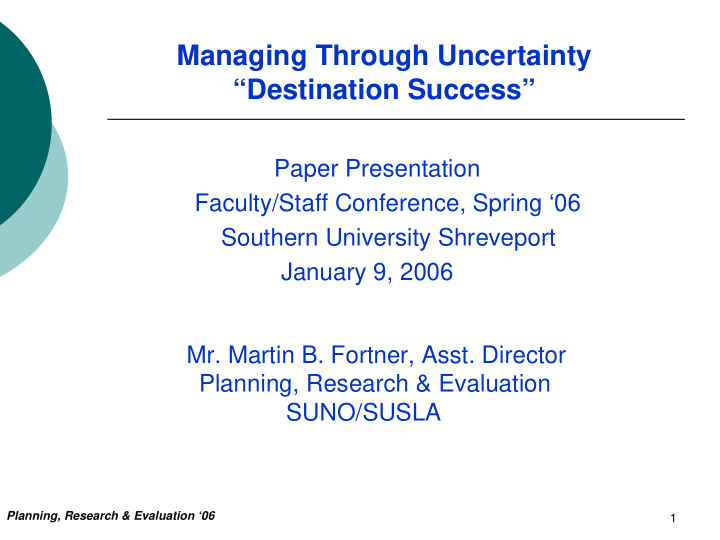



Managing Through Uncertainty “Destination Success” Paper Presentation Faculty/Staff Conference, Spring ‘06 Southern University Shreveport January 9, 2006 Mr. Martin B. Fortner, Asst. Director Planning, Research & Evaluation SUNO/SUSLA Planning, Research & Evaluation ‘06 1
Transforming Louisiana Postsecondary Education � Louisiana Vision 2020 • Education Learning Enterprise • Selective Admissions • Institutional Strategic Planning • HBCU Selective Admissions Transition � Performance Measurement • Enrollment, Retention,& Graduation • Academic Program Accreditation • Teacher Quality • Technology • Economic Development Impact 2 FL/ ‘06
Strategic Planning “Linking Education to Economic Development” � Knowledge - Based Economy • Education-Learning Enterprise • Core Missions Inclusive of Eco. Development • Enrollment, Retention & Graduation • Reduce Minority Achievement Gap • Workforce Preparation & Participation • Instructional Quality • Pedagogy Paradigms / Core Skills & SMET • Technology 3 PRE/AIR/ ‘04
Southern University at Shreveport “A Framework for Success” Environmental Context � Afford Citizenry increased opportunities for Higher Learning. � Ninety Seven Percent Enrollment Increase Since AY ’00/01. � Balance Traditional/Non-Traditional Student Population. � Sensitive to Labor Market Trends. � Open Admissions. � Increasing Retention and Graduation Rates. 4 FORTNER/LITTLE/ AIR/ 02
Retention & Completion Rates “Opportunities for Improvement” First Time Full Time Retention Rate Average 58 percent. � Three to Six Year Graduation Rate 5 Year Average 21 Percent. � Highest Graduation Rates for State Public 2-Year Institutions. � Socio Economic Factors such as Poverty, Family Demographics, � Urban Area, Transfers and Developmental Education affect Degree Attainment Timeframes. � Peer Group To Assess Similar Matriculation Processes And Identify Best Practices for Remediation. 5 PRE/ AI R/ ’0 4
Enrollment Headcount 3000 2500 2331 2230 2000 1925 2208 1445 1184 1500 1764 1644 1410 1000 1176 500 0 2000/01 2001/02 2002/03 2003/04 2004/05 1176 1410 1644 1764 2208 Basline 1184 1445 1925 2230 2331 Actual SUSLA Annual Strategic Benchmarks
Three/Six Year FTF Cohort Graduation Rates 30 25 24.2 21.9 21.2 20 18.7 18.5 15 10 7.5 7.5 5.1 5 4.0 1.7 0 2000/01 2001/02 2002/03 2003/04 2004/05 1.7 4.0 5.1 7.5 7.5 Baseline 18.7 18.5 21.2 24.2 21.9 Actual SUSLA Annual Strategic Benchmarks
Three/Six Year FTF Cohort Comparisons 25 20.91 19.06 20 16.18 15 10.64 10 6.42 5 0 SUSLA LSUE NUNEZ BPCC DELGADO Academic Years '00/01 Thru '04/05
FTFTF Retention Rates 80 70 63.6 67.1 57.1 60 50.7 51.7 55.0 55.7 53.7 50 50.3 40 30 20 10 0 00/01 01/02 02/03 03/04 04/05 50.7 51.7 53.7 55.7 55.0 Baseline 50.7 50.3 63.6 67.1 57.1 Actual SUSLA Annual Strategic Benchmarks
Percentage of Part Time Enrollment SUSLA 50 45 40 35.5 33.3 35 30.3 30 27.7 21.9 Percentage 25 20 15 10 5 0 2000/01 2001/02 2002/03 2003/04 2004/05 Academic Years
Part Time Enrollment Comparisons Academic Years 2000/01 Thru 2004/05 70 54.4 45.8 49.4 47.83 42.5 60 50 29.7 40 Percent 30 20 10 0 SUSLA DCC BPCC NUCC BRCC LSUE Two Year Public Institutions
Redirecting Strategic Initiatives “ Emphasizing Desired Outcomes” Performance, Effectiveness & Accountability. � Refocus Enrollment Management Projections (Diversity). � Maintaining Full-Time/Part-Time Student Population Ratios. � Enhancing Academic Relevance and Instructional Quality � Increasing Retention & Graduation Rates. � Measuring Post Matriculation Outcomes. � 12 PRE/ AI R/ ’0 4
Defining Our Product “ A Learning Enterprise” � Institutional Effectiveness • Link Unit Goal Attainment To Institutional Mission “ • Establish Annual Performance Targets • “Bottoms Up Review” - All Operations • Conduit for Funding Stream Identification • PBBS in Conceptual Design Phase � Reporting Emphasis: Cost Maximization • Goals Goals : : Access, Success, Accountability and Quality Cost containment Cost efficiency Cost avoidance Cost liability Value Added 13 FL/ ‘03
Affecting Organizational Change “Establishing Accountability Levels” Strategic Planning / Vision 2020: Vibrant Balanced Economy � With a Well-Educated Workforce & Improved Life Quality. Institutional Operational Plans: Establish Annual Performance � Targets and Reporting Strategic Goal Attainment Activities. Performance Based Budgeting: Cost Maximization & Resource � Utilization. Emphasis: Cost Avoidance, Cost Liabilities & Cost Effectiveness. Academic Affairs/Deans: Policy Selection Goal Achievement. � SACS/QEP(s): Linking Academic Program Units � Into the Strategic Planning & Reporting Process. 14 PRE/ AI R/ 0 4
Performance Based Budgeting “Cost Indicators ” Outcomes Assessments and Strategic Planning Program Enrollment, Graduation and Retention Rates Course Completion/Success Rates � Instructional Workload Statistics � Frequency of Course Offerings � E Learning Courses/Technology � Learning Outcomes � Instruction & Research � Faculty Professional Development � 15 PRE/ AI R/ 0 4
Evaluation/Reporting Continuum “Entry to Exit” Assessments” Core Data Systems Statewide Student Profile System /Explorer � IPEDS � Performance Based Budget Planning & Reporting � Enhanced University Assessment Capability Perception Based Surveys � Knowledge, Skills & Abilities ( Pedagogy) � Development of Core Indicators/SEIS. � Outcome Assessment (Future Efforts) Quality of Academic Experience � Post Matriculation Specialization � Employment Earnings Evaluations � 16 PRE/ AI R/ 0 4
Institutional Research “Leading Organizational Change” “Leading Organizational Change” Strategic Planning/Institutional Effectiveness Predicated on Contingency Management Concepts � D. P. Jones, 1982, (IR) Prospective Role: � Where is the organization at this moment? Where is the organization going? How can the organization best achieve desired ends? 17 FORT/LITT/AIR/ 02
18 How Do We Achieve Success “A Willingness to Change” “The Next Phase” Communication Mutual Respect Cooperation Trust � � � � FORTNER /AIR/02
Recommend
More recommend